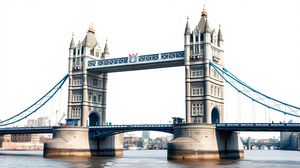
HMS Belfast is a historic Royal Navy warship permanently moored on the River Thames in London. Launched in 1938, she played a crucial role in significant naval engagements of World War II, including the Arctic Convoys and the D-Day landings. Today, this floating museum offers visitors an immersive experience into Britain's naval history.
Aboard HMS Belfast, visitors can explore nine decks filled with original artifacts and interactive exhibits. The ship's engine room, with its labyrinth of boilers and turbines, is particularly fascinating and provides a unique insight into the ship's operational era.
Interestingly, HMS Belfast is painted in a "Western Approaches" camouflage, designed to make ships less visible in the open ocean. This distinctive design is both functional and surprisingly artistic, offering a rare glimpse into naval warfare strategies of the mid-20th century.
The ship's radar and gunnery systems were state-of-the-art when she was in service. Visitors can tour the gun turrets and imagine what it was like to fire her powerful 6-inch guns, which were once capable of hurling shells over 12 miles away.
HMS Belfast holds a unique place in history as one of only three surviving bombardment vessels from the Normandy landings, and she now serves as a living testament to those pivotal battles of World War II.
One of the more intriguing facts about HMS Belfast is that she was originally intended to be scrapped in 1939. However, the outbreak of World War II extended her life, and she went on to have a distinguished career. It's a testament to her durability and the changing tides of history.
Climbing up to the Captain's Bridge, visitors are rewarded with stunning panoramic views of London, giving a commanding perspective over the modern city's skyline juxtaposed against this wartime relic.
Beyond the history and military artifacts, HMS Belfast also provides an insight into the daily lives of the sailors who served on her. From the cramped sleeping quarters to the galley where meals were prepared, the museum brings to life the stories of those who once called her home.

Making the Most of Your Visit:
When you visit HMS Belfast, allocate a bit of extra time for a detour to the Fo'c'sle (Forecastle) at the very front of the ship. It's not the most obvious part to explore, but the view of the ship from here is fantastic, and you can really imagine what life would have been like for sailors braving the cold seas.
Make sure to download the HMS Belfast app before you go. It's packed with audio guides, which can really enhance the experience and give life to the stories you're exploring. It's like having your own personal tour guide in your pocket!
For a glimpse into the social side of naval life, check out the Ship's Company Living Quarters. Not everyone knows about this spot, but it's a great way to see how sailors lived, and the mannequins dressed in period uniforms can be quite eye-opening.
If you have kids with you, they will love the Operations Room. It's designed with lots of hands-on exhibits and interactive screens that will keep them entertained and engaged with the history—plus, it's a lot of fun for the adults too!
Don't miss visiting the Quarterdeck where you can step back in time and imagine the strategic decisions being made. Sometimes it's open for special events or demonstrations, which are really quite interesting if you can catch one.

Visiting Times & Costs:
HMS Belfast is open to the public daily, except for select holidays. The usual opening hours are from 10:00 AM to 6:00 PM, with the last admission at 5:00 PM. Please note these hours can vary, so it's always a good idea to check ahead for any changes.
Admission to HMS Belfast involves an entrance fee. As of the latest information, general adult tickets are priced around £25.00, with discounted rates available for children, seniors, and students. Family tickets are also available at a reduced rate for groups.
There are some accessibility considerations to be aware of. Due to the nature and age of the ship, not all areas are fully accessible by wheelchair. However, efforts have been made to accommodate visitors with mobility issues, including the provision of virtual tours and assistance from the museum staff whenever possible.
It is suggested to check for any specific accessibility concerns or updates during planning, as provisions may improve or change over time.

Address & Map:

Nearby:























